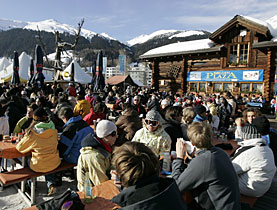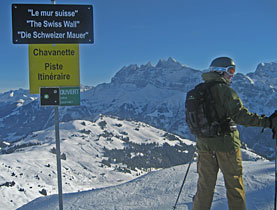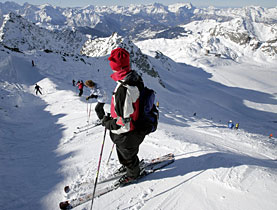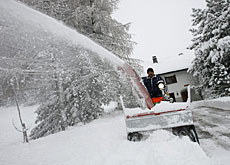Tourism officials rub their hands

This Christmas and New Year hotels in resorts across Switzerland were full, restaurants did a roaring trade, and cable cars carried more passengers than ever.
“Two great weeks”, “excellent results”, “outstanding”, “a record”. These were just some of the comments by tourism officials all over the country as they looked back over the two-week holiday.
Day trippers and longer-term guests both contributed to the surge in figures.
A combination of factors lay behind the encouraging results. The weather played an important part. Conditions were ideal throughout the country with plenty of snow and sun.
Many people took additional days off to spin out the official Christmas and New Year holidays by taking in the intervening weekend.
Visitors from abroad swelled the ranks of Swiss holidaymakers: for them, the relative weakness of the franc against the euro brought down the cost of a holiday in Switzerland, in previous years often regarded as an expensive choice. The franc has fallen by 11 per cent against the euro in the past four years.
Rail bonus
Resorts in the southwestern canton of Valais benefitted from an additional bonus: the opening in December of the new Lötschberg rail tunnel, which has cut travelling time dramatically between the major population areas of northern Switzerland and the popular destinations in the south.
Thanks to this reduction, skiers from the Bernese Oberland have started buying season tickets for Valais, according to Urs Zenhäusern, director of Valais tourism.
The resort of Crans Montana had 13,000-14,000 skiers on its slopes every day, while on Verbier’s best day, January 1, there there 16,000. Cable cars and ski lifts reported record turnover: up by 60 per cent in Gstaad in the Bernese Oberland, and by one third in the Wildhaus area of Toggenburg in eastern Switzerland.
Inevitably, the influx has brought its own problems. People travelling by car have found themselves facing delays in driving to the ski stations, and there have been queues at the ski lifts.
The Rega air rescue service was also busy. In the first two days of 2008 alone it flew 65 missions. Demand was so high that at times extra helicopters had to be brought in to help out, Rega speaker, Gery Baumann, said.
Since the unusually early start to the season in November the service has flown two to three times more missions than in previous years.
It was not only Rega which was busy: the Air Zermatt rescue service was also called out 37 times.
swissinfo with agencies
Young people in Switzerland ski less than they used to, and fewer schools arrange ski weeks for their pupils.
Some ski areas are trying new pricing schemes to make skiing more affordable.
Switzerland’s attractiveness to foreigners is affected by the exchange rate between the euro and the Swiss franc.
In the long term, resorts at lower altitudes face the prospect of snowless winters as a result of climate change.
The amount of snow fluctuates from year to year. The winter of 2006-7 was the warmest on record, but there was more snow at the beginning of the 2007-8 season than there had been for more than 50 years.

In compliance with the JTI standards
More: SWI swissinfo.ch certified by the Journalism Trust Initiative



You can find an overview of ongoing debates with our journalists here. Please join us!
If you want to start a conversation about a topic raised in this article or want to report factual errors, email us at english@swissinfo.ch.